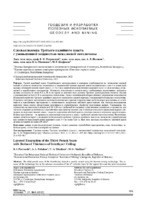| dc.contributor.author | Петровский, Б. И. | |
| dc.contributor.author | Поляков, А. Л. | |
| dc.contributor.author | Мисников, В. А. | |
| dc.contributor.author | Шафиков, М. Г. | |
| dc.coverage.spatial | Минск | ru |
| dc.date.accessioned | 2022-12-09T07:33:46Z | |
| dc.date.available | 2022-12-09T07:33:46Z | |
| dc.date.issued | 2022 | |
| dc.identifier.citation | Слоевая выемка Третьего калийного пласта с уменьшенной мощностью межслоевой потолочины = Layered Excavation of the Third Potash Seam with Reduced Thickness of Interlayer Ceiling / Б. И. Петровский [и др.] // Наука и техника. – 2022. – № 6. – С. 455-463. | ru |
| dc.identifier.uri | https://rep.bntu.by/handle/data/123386 | |
| dc.description.abstract | Третий калийный пласт Старобинского месторождения в основном отрабатывается по технологии слоевой выемки. Сущность технологии заключается в опережающей выемке верхней лавой сильвинитового слоя 4 и совместной выемке отстающей нижней лавой слоев 2, 2–3 и 3 под защитой межслоевой пачки каменной соли 3–4 (потолочины), оставляемой в выработанном пространстве. Мощность потолочины в соответствии с требованиями нормативного документа должна составлять не менее 0,8 м. В то же время на шахтном поле рудника Третьего рудоуправления имеются участки с уменьшенной до 0,66–0,70 м мощностью потолочины. Целью исследований авторов являлось определение возможности безопасной отработки Третьего калийного пласта по технологии слоевой выемки с уменьшенной мощностью потолочины. В процессе натурного эксперимента изучены геологическое строение и прочностные свойства пород потолочины, ее устойчивость в призабойном пространстве и интенсивность нагружения забойной крепи нижних лав. Методы исследования включали также анализ литературных источников и статистическую обработку полученных данных. Установлено, что уменьшение мощности потолочины на 0,10–0,14 м от требуемой не оказывает существенного влияния на ее прочность, при этом она сохраняет устойчивость в призабойном пространстве нижних лав. Основные показатели проявления горного давления в исследуемых нижних лавах – скорость нарастания забойной крепи в очистных циклах и опускание кровли в призабойном пространстве – не превышали аналогичные показатели в лавах с требуемой мощностью потолочины. Полученные данные свидетельствуют о возможности безопасной отработки Третьего калийного пласта по технологии слоевой выемки при мощности межслоевой пачки каменной соли 3–4 не менее 0,66 м. При этом несущая способность забойной крепи должна составлять не менее 550 кН/м2. | ru |
| dc.language.iso | ru | ru |
| dc.publisher | БНТУ | ru |
| dc.title | Слоевая выемка Третьего калийного пласта с уменьшенной мощностью межслоевой потолочины | ru |
| dc.title.alternative | Layered Excavation of the Third Potash Seam with Reduced Thickness of Interlayer Ceiling | ru |
| dc.type | Article | ru |
| dc.identifier.doi | 10.21122/2227-1031-2022-21-6-455-463 | |
| local.description.annotation | The third potash seam of the Starobinsky deposit is mainly mined using the layered mining technology. The essence of the technology lies in the advance excavation of the 4th sylvinite layer by the uppere lava and the joint excavation of layers 2, 2–3 and 3 by the lagging lower lava under the protection of the interlayer pack of rock salt 3–4 (ceiling) left in the goaf. The thickness of the ceiling in accordance with the requirements of the regulatory document should be at least 0.8 m. At the same time, in the mine field of the mine of the Third Mine Administration, there are areas with a ceiling thickness reduced to 0.66–0.70 m. The purpose of the author’s research was to determine the possibility of safe mining of the Third potash seam using the layered mining technology with a reduced thickness of the ceiling. In the course of a full-scale experiment, the geological structure and strength properties of the rocks of the ceiling, its stability in the bottomhole space and the intensity of loading of the bottomhole lining of the lower lavas have been studied in the paper. The research methods also included the analysis of literary sources and statistical processing of the obtained data. It has been established that a decrease in the thickness of the ceiling by 0.10–0.14 m from the required one does not have a significant effect on its strength, while it remains stable in the near-bottom space of the lower longwalls. The main indicators of the manifestation of rock pressure in the studied lower longwalls – the rate of increase of the bottomhole lining in the stope cycles and the lowering of the roof in the bottomhole space – did not exceed the similar indicators in the longwalls with the required thickness of the ceiling. The obtained data indicate the possibility of safemining of the Third potash seam using the layered excavation technology with the thickness of the interlayer rock salt pack 3–4 not less than 0.66 m. In this case, the bearing capacity of the bottomhole lining should be at least 550 kN/m2. | ru |

